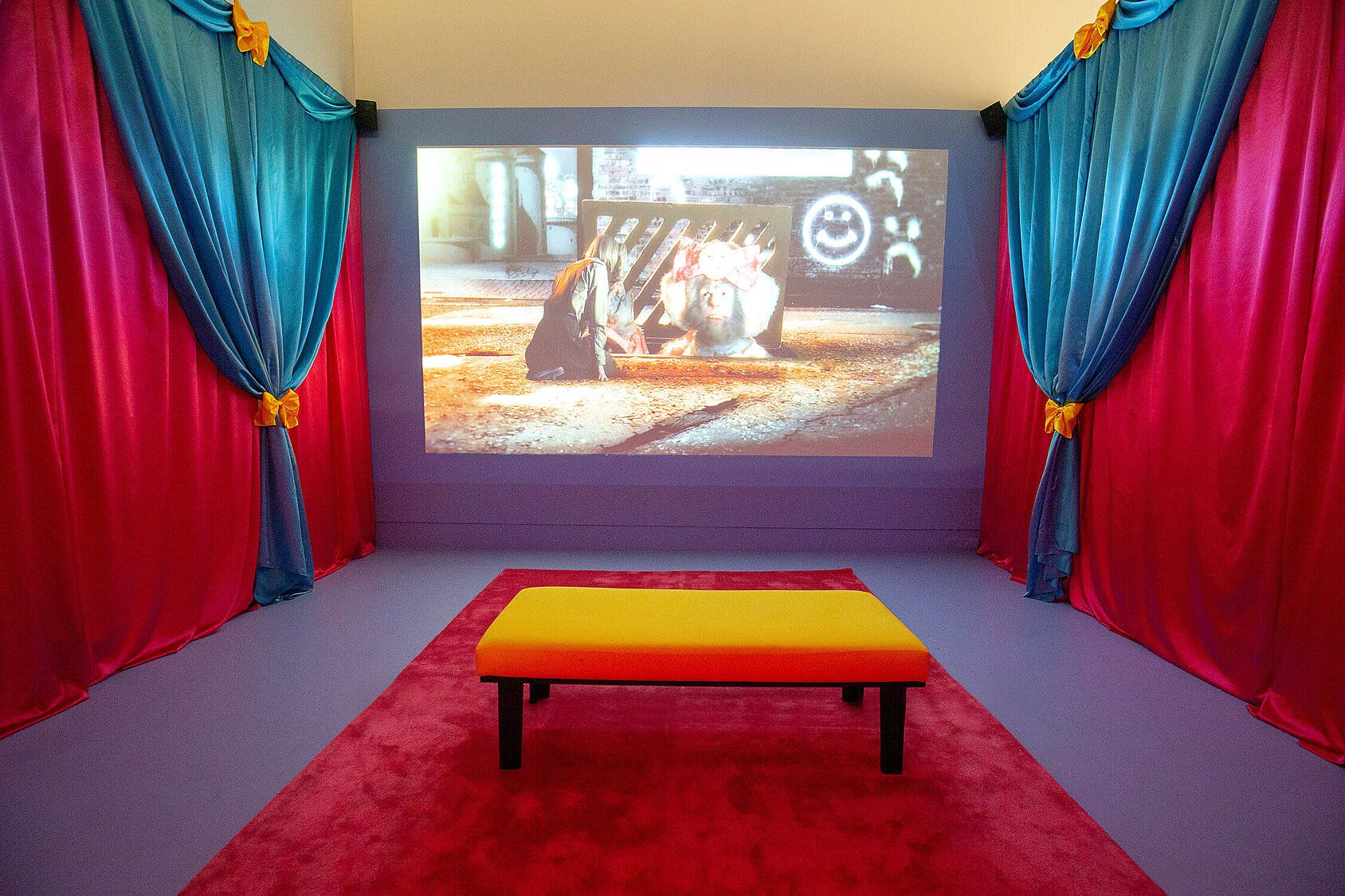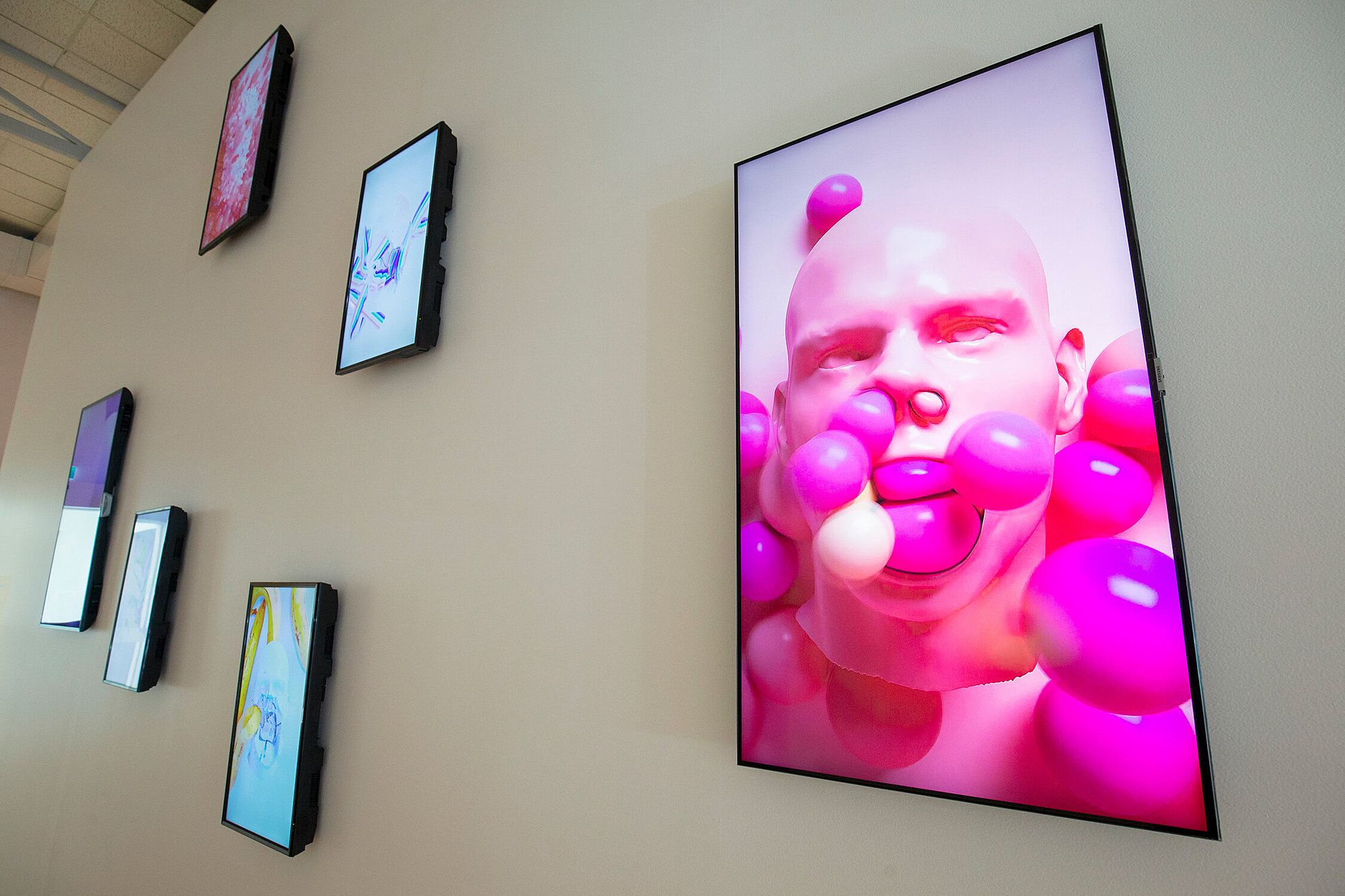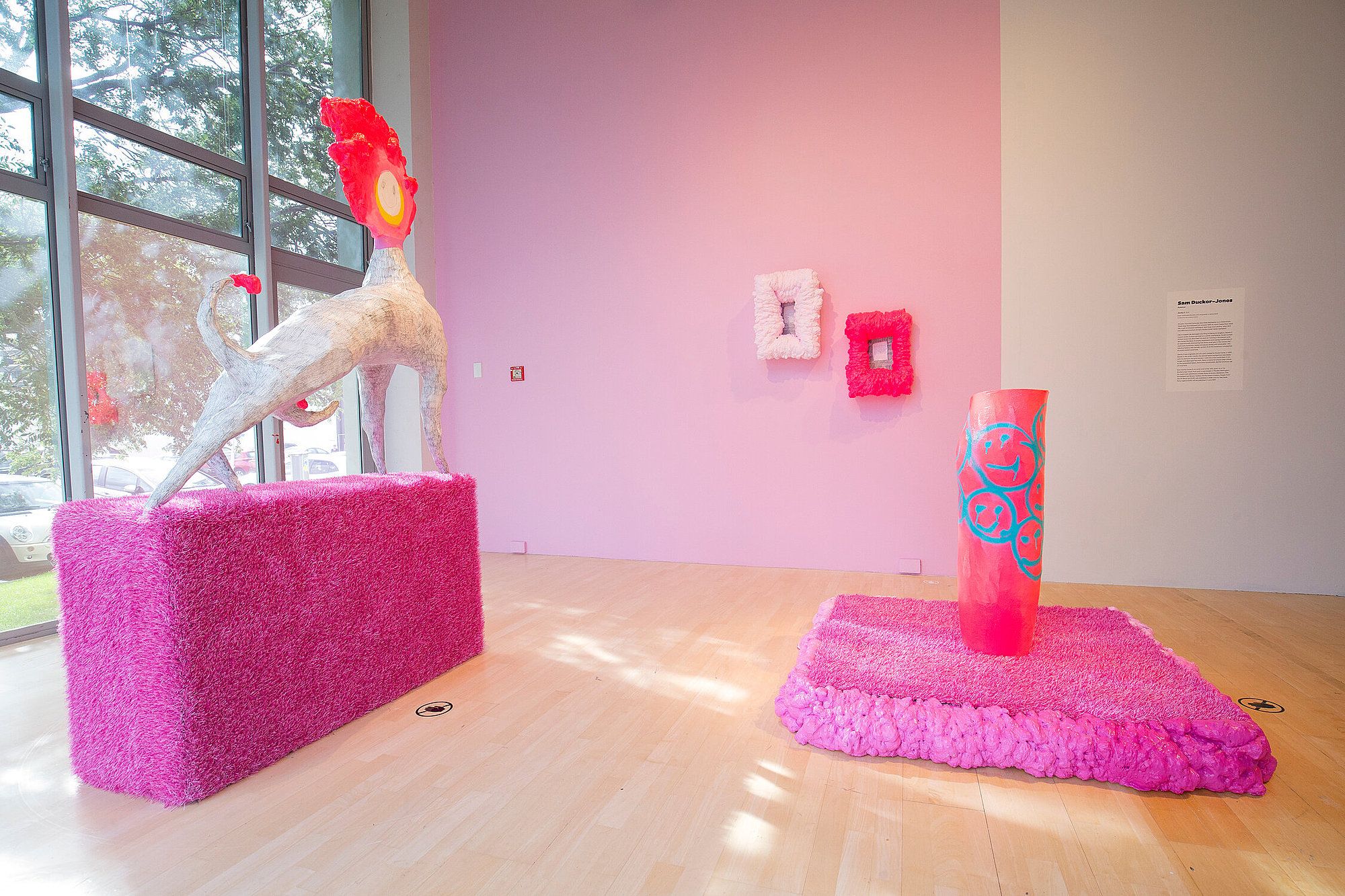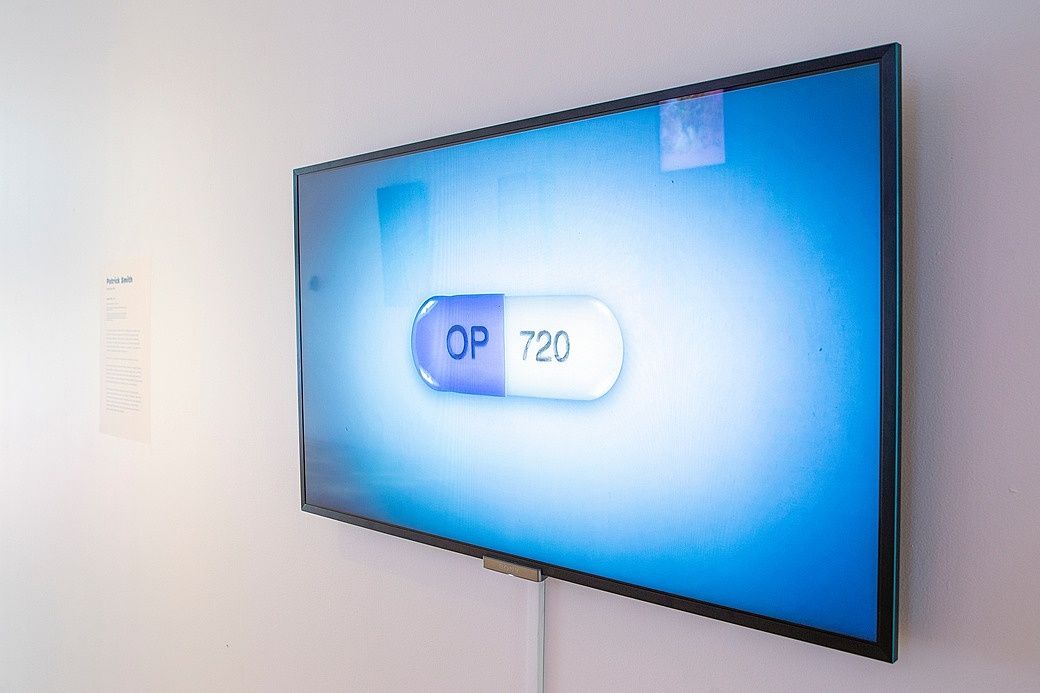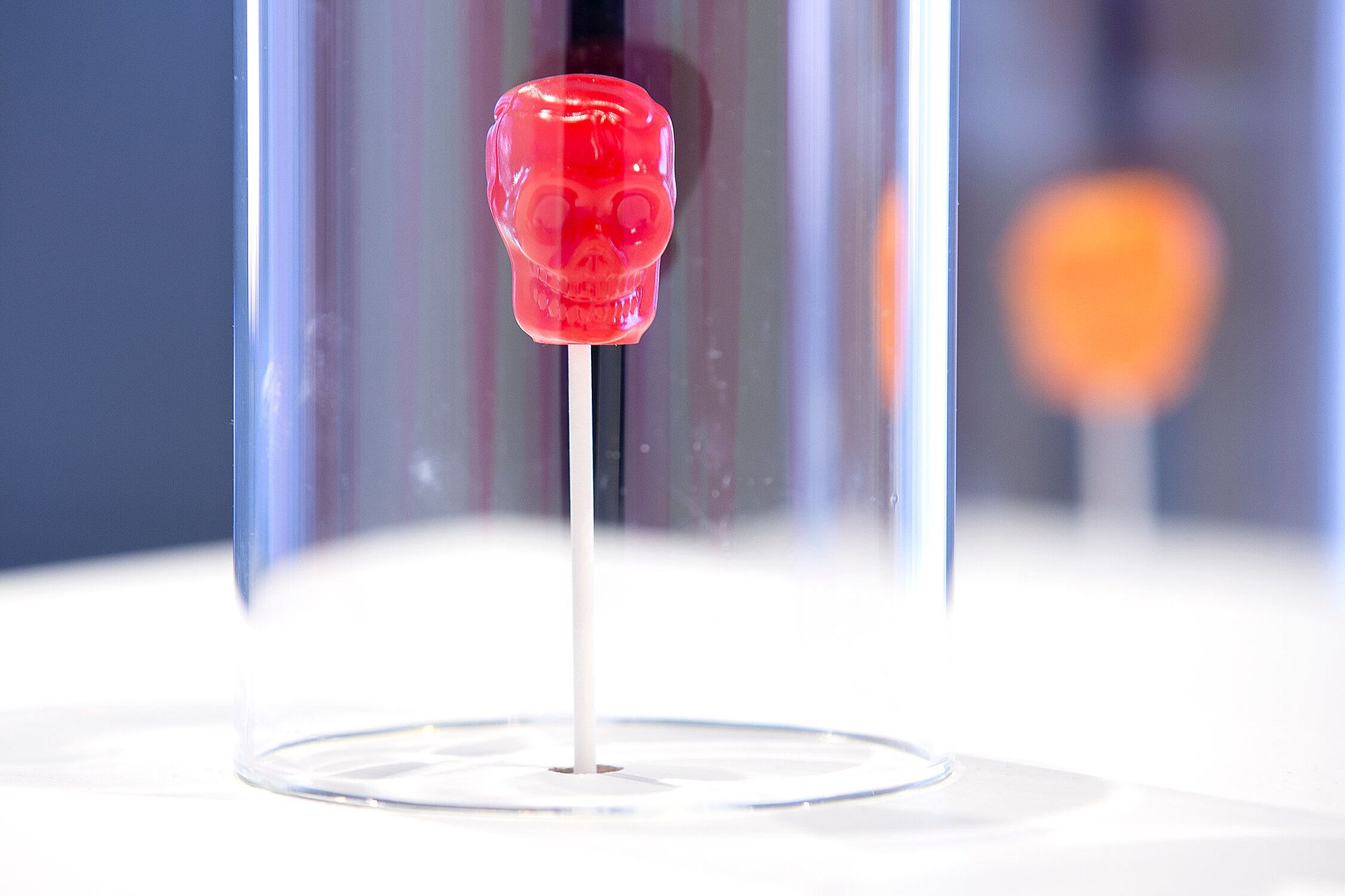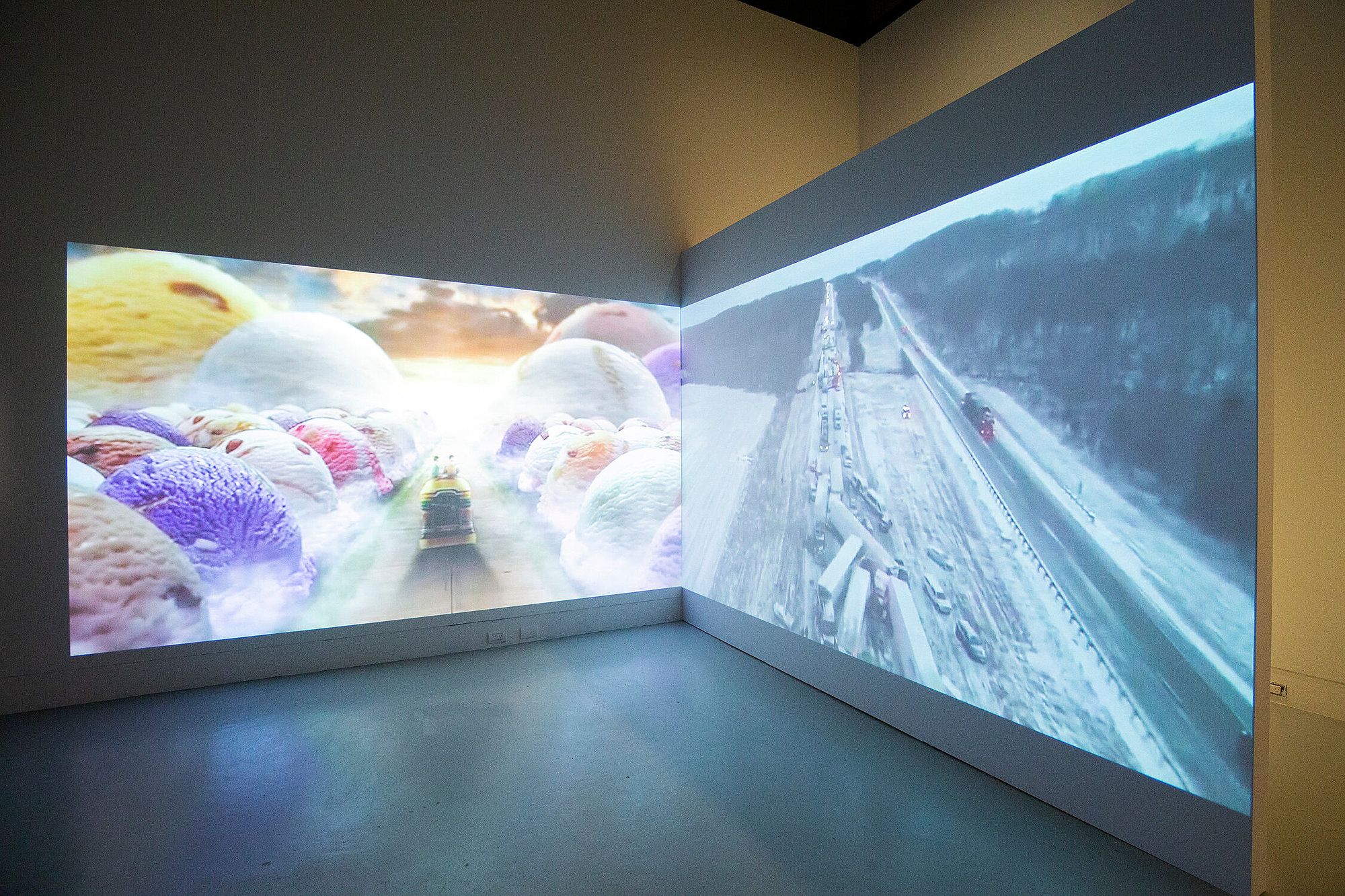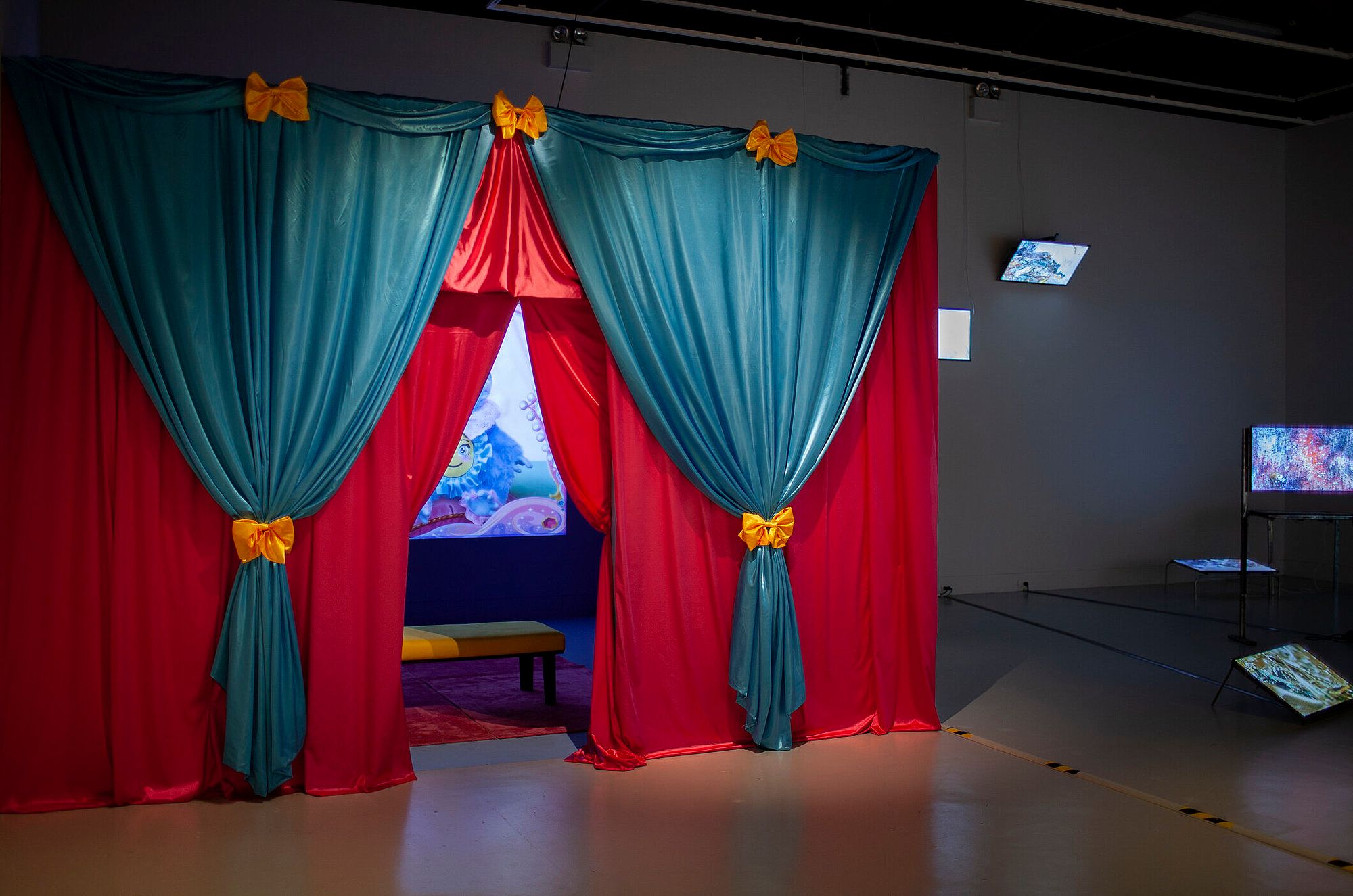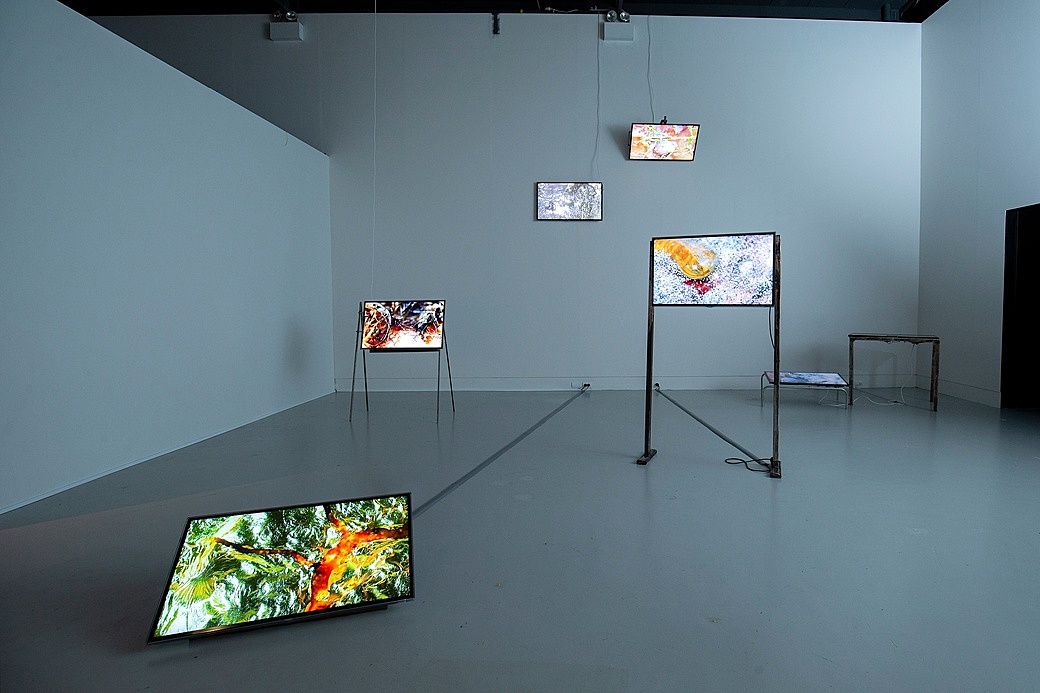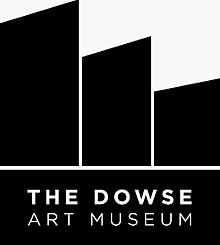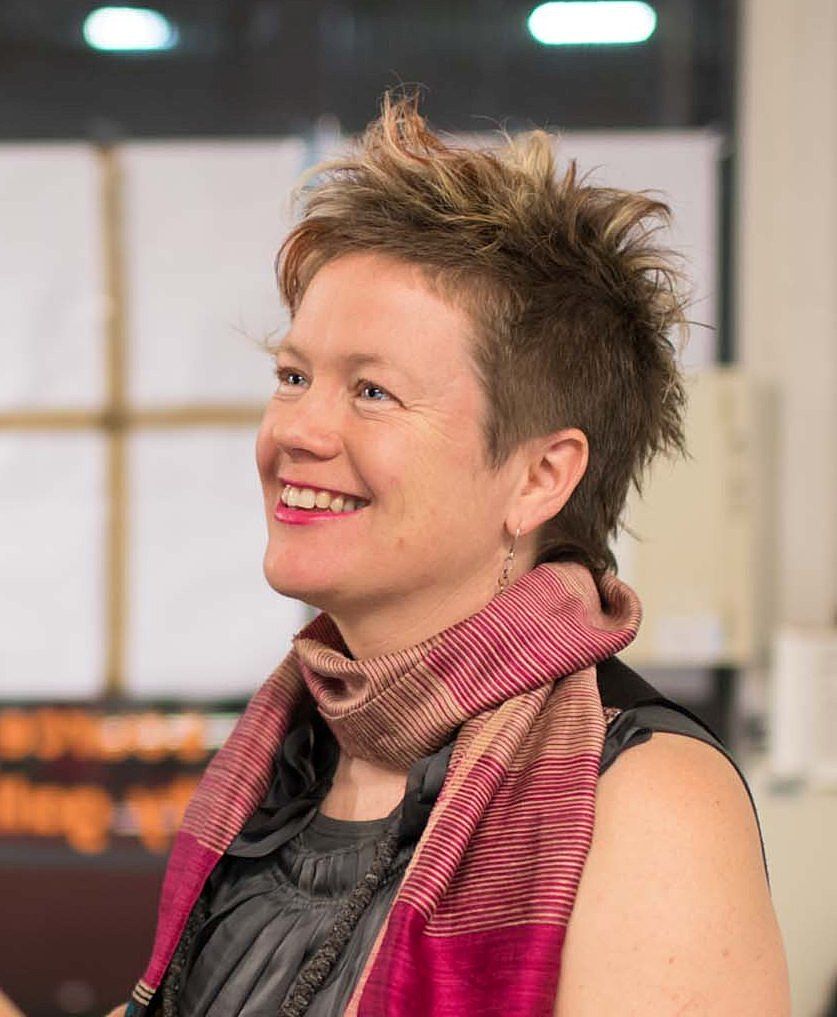Happy Birthday!
A sickly sweet 50th anniversary show at The Dowse delves into the depths of human depravity and obsession with that which should perhaps be left to rot.
Candy Coated is a 50th anniversary show at The Dowse. The title tells us what to expect – beautiful, bright colours, slick finishes, and surfaces that dissolve to reveal what is underneath. Like all good birthday parties, it has cake, lollies, and guests with things in common and lots to say to one another. There are nine artists in this show, from Aotearoa and overseas. The conversations here range from staying on the surface while eating all of the lollies to sudden plunges to depths that create an awkward silence, wondering whether I should say something.
Celebrations / Fun / Pressure / Perfection / Cracks / Surface
After last year, it’s understandable to be looking for a bit of escape. This show offers us a visual language of childhood while using our desire to escape as a portal, or maybe more like a hall of mirrors. We don’t get away, but through – we are looped back around to what we want to avoid because it’s there already, in our desire, and where that can take us. Desire to be protected, taken care of, to be successful, happy. To have easier choices, for it to be simpler, like it used to be.
Jon Noorlander, Exploding Heads Series, 2019-2020
Repetitive / Colourful puking / Explosions
Head stretched, bubbly bubble-gum. Sicking up bananas, then a face left crumbled like a broken ceramic shell. We are what we eat? In Jon Noorlander’s Exploding Heads I’m casting around for meaning while clay-like heads explode with outpourings of Smarties. It’s keeping me on the surface, and then I remember that this is where we have wanted to be. The depths are just too bottomless right now. The repetition and the weirdness and the sweetness somehow sum up something about this current moment. I don’t know what it is, but it’s something like – I just wanna stuff my face and not think too much thanks cos my head is exploding.
Sam Duckor-Jones, Devilry 2, 2019
Play / Neon pink / Resistance / Queerness / Shame / Destruction / Honesty
There’s a lion down the end. It's a proud lion with pink hair. Or is it a deer / fawn? Its front leg is holding it up. Joyfully posing, balancing like a swift drawing; light and energetic – this is Devilry 2 by Sam Duckor-Jones. Devilry 1 is missing, the loss acknowledged on paper, framed in expanding foam, “AFTER BEING SET FREE AMONGST THE YELLOW MATTRESSES AND ROT OF OUR HAPPIEST VALLEY.” Plaques usually speak of status, but this one honours destruction and joy. Apparently, Devilry 1 had taunted him until he destroyed it. Too colourful? Too playful? I looked up Devilry 1. It had a bigger pink mane – flowing and flooding down the back, covering the underneath penis/tail.
Alok Vaid-Menon (they/them), author, performer, speaker, fashionista, wrote recently:
“People fear queer people because we don’t wait to experience joy; we seize it, embody it, and practice it in the here and now. And in doing so – we rupture the narrative about how they have organised their lives … Heteronormative culture dismisses queer rituals as ‘superficial’ ‘phases’, like ‘playing dress up’.
It’s powerful that in this work Duckor-Jones shows us the proud, playful lion and the one that he couldn’t stand anymore. What Vaid-Menon describes is hard work. Success isn’t about always coming up shiny and covered in glitter, but about showing the battle for what it is: embodied and confronting, with loss, pride and shame often side by side.
Patrick Smith, Candy Shop, 2019
Speed / Pills / Time / It aint that easy / It’s a con
Patrick Smith is next, showing us pharmaceutical drugs. They flash past – 2863 of the 11,926 on the market, the wall label tells us. Fast, rhythmic images of pills becoming interspersed with sweets. The music is fast too – keep up! The speed becomes both hypnotic and hectic, far too fast to choose or discern between the products. Smith is showing us the scale of the business of controlling pain or being sold the idea of It’s easy, and should be fast.
Getting well takes time, and that’s not something that capitalism, based on your worth as a productive unit, allows. Author Srinidhi Raghavan is part of the movement that has created the term ‘crip time’ – time as dictated by bodily need, rather than an external imperative. She says:
“I began to write notes to myself about how healing is slow. How work can be slow too … But I have found that when the world slows down along with me – for some reason – my anxiety disappears. My body melts into the slowness and feels respite.”
Sometimes we need the sugary cup of tea for shock, and pills can give us enough support to get us through the first bit, the worst pain – enough to then figure out what we need next. But what Smith shows us is a barrage of product marketing and associations, driven by a desire to sell to us rather than help us get well. For more on this, see artist Nan Goldin’s activism with Prescription Intervention Action Now (P.A.I.N), the opioid crisis and the ties between the art world, donors, and pharmaceutical companies.
Wayne Youle, Skully-Pops (Death of the Tiki Pop), 2006
Colonisation / Ownership / Greed / Protest / Showing it up
Wayne Youle’s (Ngāpuhi, Ngāti Whakaeke, Ngāti Pākehā) series of sculptures Skully-Pops (Death of the Tiki Pop) are physically small, but these colourful skulls on sticks speak loudly. Lollies on sticks we put in our mouths and suck, right? Like a dummy for adults: something we can take in and out again at will. The wall text reminds us that “In tikanga Māori, the head is tapu, the most sacred part of the body – the idea of licking it is unthinkably absurd”. But the Western mind loves to touch and have, and to and ridicule boundaries, including body sovereignty. Common among colonisers – enough that it’s a well-known behaviour to touch the head. Regardless of what it means. Solange tells us in the song ‘Don’t touch my hair’, “They don’t understand what it means to me / Where we chose to go / Where we’ve been to know.” Displayed in glass domes, these skully-pops speak to the toi moko that Pākehā took from Māori, in what is described here as ‘problematic histories’. Taken out of context, out of cultural meaning and into the ownership of museums and private collections. In Te Papa’s Repatriation Questions and Answers we learn:
“Of the 107 Māori and Moriori remains returning from New York, 35 are Toi moko (Māori preserved heads) associated with a British soldier and collector called Major Horatio Robley. In the 1860s, Robley was in New Zealand as a colonial soldier and became extremely fascinated with the Māori people and the Toi moko. When he returned to the United Kingdom, he became an avid collector of Toi moko, and in the latter part of his life, he had hoped to return his collection of 35 ancestral heads back to New Zealand. At that time, the New Zealand Government was not agreeable to the arrangement, and the collection was sold to New York in 1907.”
These skulls say, You treated us like lollies.
Alison Nguyen, Dessert-Disaster, 2017-2018
Screaming / Ooohs / Aaaahs / Excess / Desire / Destruction / Ice-creams / Lava
“Oh my gawd! Oh my gaaaawd! Whoo hooo hoo!
Oh my gaaaaaaawd, that is… OOOOUUUHHH!!!”
It’s an out of control spectacle, filmed. How far can we go? How exciting! How high can we build? WHAT IF WE WENT HIGHER? And then watch it all come down.
Alison Nguyen’s Dessert – Disaster shows us, in abstract and beautiful/horrifying contrasts, the desire and excitement of ‘letting go’ of control. It’s not about the actual doing, though – it’s about watching it happen. Adverts designed to activate desire; through repeated perfections of creaminess, crushes of juicy strawberries and rivers of chocolate, alongside the destruction of built and natural environments collapsing from height and oozing lava. All while we listen to sounds of excitement and thrill that chillingly match both.
This draw towards destruction and excess is scary right now as we face climate change. Nguyen confronts us with our disembodied looking; capturing, and uploading dramatic spectacles, over embodied connection, interdependence and concern. Western thought divides the mind and the body and has treated the land as a separate resource, to be dominated and owned. And it is collapsing. We need better relationships, embodied, interconnected ones. In the book Conflict Resolution for Holy Beings, Joy Harjo, of the Muscogee Creek Nation and poet laureate of the United States, writes:
“When the sun rises at the apex of the ceremony, we are renewed.
There is no mistaking this connection, though Walmart might be just down the road.
Humans are vulnerable and rely on the kindnesses of the earth and the sun; we exist together in a sacred field of meaning.”
Elisa Barczak, Salad Days Are Gone, 2016
Memory / Tokens / Something to hold on to
Salad Days Are Gone by Elisa Barozak is a display, like a shop selling ceramic lollies. I always feel like I am missing something with this kind of realism – objects painstakingly recreated as art, valuable versions of a $1 lolly bag. But in this show, artworks resonate with and amplify each other. Some of the works in this show make me feel disembodied, creeped out and floaty, like Feed Me by Rachel Maclean. After visiting this brilliant and revolting fairy-tale/horror-story world, the ceramic snacks feel valuable – like ones that might lead you out of the forest because they don’t get eaten by birds. I want to come back into my body. I want to hold one of those ceramics in my hand, feel its coolness and think about the simple and repetitive handwork of making these things. Two people next to me have this conversation:
“Ooh yum!
They bring back memories…
They’re not real though.”
Rachel Maclean, Feed Me, 2015
Instructions / Peer pressure / Being happy /Greed / Desire / Belonging / Threat / Scarcity / Conformity /Pretence / Ageing / Money / Control / Power / Abuse
Content warning: This work depicts grooming, a capitalist and dangerous surveillance state, and references to child sex abuse.
There are things in this show that I don’t want to be real. I don’t want predatory adults to groom and trick and manipulate children. I don’t want a world made by adults that’s tricky and sick, with no escape. But it exists. Any time I turn on Radio New Zealand, I might hear a first-hand account, as survivors tell their stories through the Royal Commission of Inquiry into Abuse in Care. Their stories are real, alright, in horrifying ways.
Rachel Maclean’s 60-minute film Feed Me is an alternative dystopian reality in which she plays all the characters. It’s a grim fairy-tale, with blue beasts and grandmas, full of hooks back into our daily life. In the film, smiley faces speak to likes on Facebook, knowing we are being surveilled and our data collected. Youth, happiness and cuteness are the goals, they define products we buy and the currency we trade in. An advert for ‘Happy Skin’, an anti-ageing cream, says, “It’s the science I trust to make me look childish.” Boom. Not ‘younger’ but childish. Because that’s the logical conclusion of trying to look younger, putting models on the runway who look like teenagers. We are paying money to look more like teenagers, to look more like children.
Everyone is old, with highly made-up latex skin peeling off at the edges. There’s a monster locked away eating baby sweeties.
There are things in this show that I don’t want to be real
On the train recently, I heard an adult ask a child how they were.
“How are you – good?”
No space for an answer: the question is short and snappy, and the answer is in the question. It’s a pretty common way to ask. Recently a report into mental health services in Aotearoa was significantly delayed as senior officials in the Ministry of Health removed data they saw as ‘too negative’. It seems that telling the truth is not as highly valued as it might be. Maclean’s film shows us a nightmarish scenario of how weird things get when we try to just ‘be positive’.
The work is brilliantly clever. And it makes me feel ill. What is the responsibility of the gallery with a work like this? There’s a content warning outside the room. Both the room and the sign are dressed in satin, with big colourful bows and curtains. The sign says, “This film contains strong language and disturbing adult themes that may not be suitable for younger visitors.” It’s the wrong warning. Firstly – IT IS NOT SUITABLE FOR CHILDREN. Also, people who are older may have experienced, and might be traumatised by, the horrible places and manipulation this work shows us. A content warning should state clearly what is contained, enabling a fully informed, consensual choice. We all need protecting, and we don’t get protected by sugar coating and not quite telling the truth.
Emily Crooks, Plaything Series, 2020
Contrast
Emily Crook’s four separate photographic works Scarlett Rose, Pamela Lixx, Angel Fitz and Mitsi Loves, from the series Plaything, use pinks, satins, jewellery, feet, thighs and stockings to create scenarios of fantasy. The wall label describes the works as having a ‘nauseating quality’, but for me they seem like adults having a play and mucking about with what they’re supposed to look like to be sexy. There’s a substance in the works that they’re fondling or wearing down the side of pantyhose. The aesthetic is showing off, funny and pretty, which, for me, reads as grown-ups playing and expressing what they want through materials. All very wholesome compared to what I’d previously been looking at.
Laura Duffy, Garden of Purity: Open Your Mouth Wide and I Will Fill It, 2018
Picking up dust / Pushing / Massed tendril forests / Living / Layering / Accretion / Relief
Laura Duffy’s work is the one that grounds me and grounds the show. It is real, reality. We are all made of reality that decays, rots and regenerates. We are part of the earth, and she is part of us, and we roll together in cycles of living and dying and genuinely feeding each other. This is opposite to the yearning for youth and capitalising on the fear of losing it depicted in Feed Me. Decay and change is made beautiful in her work Garden of Purity: Open Your Mouth Wide and I Will Fill It. This is possible because Duffy has been willing to look closely, and slowly, at it. Filmed processes are placed in scuffed and welded stands. We look down as if into pools, straight into while standing; or gaze up at glittering, glimmering slickness. This is video work presented with whole-body viewing in mind. We are invited to spend time with these slow, oozing, seeping and wobbling places.
In the Garden of Eden and the story of Adam and Eve, the binaries are about good/evil, desire/punishment, and other simplistic Western divisions. Duffy shows categories to be redundant when the garden, our bodies and all living things are life, death, renewal, rot, slime and bacteria, all at once. If you look closer, the ‘disgusting’ is beautiful. The work is intimate – we know we are looking super close-up. Like a lover who is less concerned with how the whole body looks, to be judged by societal demands for conformity, youth, ‘tidiness’, I see:
Honey pushed, drawn towards a red hole.
Hairy living baubles, bubbling. Thick, slicked pink parts. Heat, sizzling, geothermal.
Silky deserts.
Foamy processes. Wet gullies. Gold, gold, gold, then green.
Breathing hair.
Amidst the hyped colours, speed, and sounds in this show, Duffy’s work relieves the senses, bringing us back to the pace of life. Reminding us – pay attention to the whole spectrum, from beauty to disgust. We are in nature, part of cycles, existing in bodies. Slow down and pay attention, so we can taste things just the way they are.
.
This piece is presented as part of a partnership with The Dowse. They cover the costs of paying our writers while we retain all editorial control.
Feature Image: Rachel Maclean, Feed Me, 2015. All photography by Hagen Hopkins.
